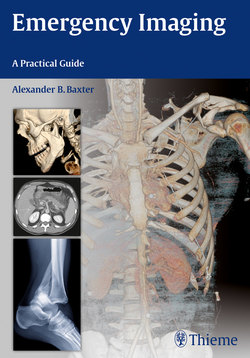Читать книгу Emergency Imaging - Alexander B. Baxter - Страница 41
На сайте Литреса книга снята с продажи.
Оглавление27
2Brain
compared with brain and approach thedensity of CSF. Unevacuated hematomasincite a local inflammatory response that leads to formation of a fibrinous capsule and fragile, vascularized membranes. Thesecan rupture spontaneously or with mi-nor trauma, and patients who have had aprevious SDH are at increased risk of hem-orrhage. Delayed bleeding into the subdu-ral space complicates up to one-third ofchronic SDHs and appears as hyperdenseclot within the lower-density hematoma.Rehemorrhage into a chronic SDH may alsoappear convex rather than crescentic due toconfinement by inflammatory membranes.
Blood fluid levels can be seen in chronic or subacute SDH complicated by rehemor-rhage, following lysis of the initial hemato-ma. Acute or subacute SDH in patients who are taking anticoagulants or are otherwise coagulopathic can also show blood fluid levels (Fig. 2.8).
◆ Subacute and Chronic Subdural Hematoma
SDHs evolve over time. Hyperacute hemor-rhage, seen in the rare patient imaged im-mediately after injury, can be hypodense or mixed-density. Most patients are im-aged after coagulation has taken place, and acute SDHs are typically hyperdense and crescentic. As an acute SDH ages, pro-tein degradation occurs, extracellular fluid shifts into the hematoma, and density decreases.
SDHs that are 2 to 3 weeks old may be isodense to the adjacent cortex and dif-ficult to detect, especially when they are small or bilateral. MRI or CT+C is more sen-sitive than NCCT for identification of these subtle hematomas. SDHs of any age can be complicated by rehemorrhage, which can convert a small, well-tolerated subacute SDH into a larger, symptomatic mass.
Three weeks or more after hemorrhage,a SDH is considered chronic. By this time,most simple hematomas are hypodense
Fig. 2.8a–f a,b Subacute subdural hematoma. (a) CT left holohemispheric subdural hematoma, near isodense to cerebral cortex. Eaced left sulci and lateral ventricle with slight left to right subfalcine shift. (b) MRI T1-weighted image more clearly shows extent of subdural hematoma.
c Chronic subdural hematoma. Low-attenuation subdural uid collections with minimal dependent blood products. Underlying cerebral volume loss and moderate symmetric compression of the frontal brain parenchyma.
d Chronic subdural hematoma with rehemorrhage. Left, isodense SDH. Right, low-density SDH with lay-ering blood products.
e,f Complex subdural hematoma. Rehemorrhage with mixed density and lenticular shape due to con-nement of clot by membranes.
